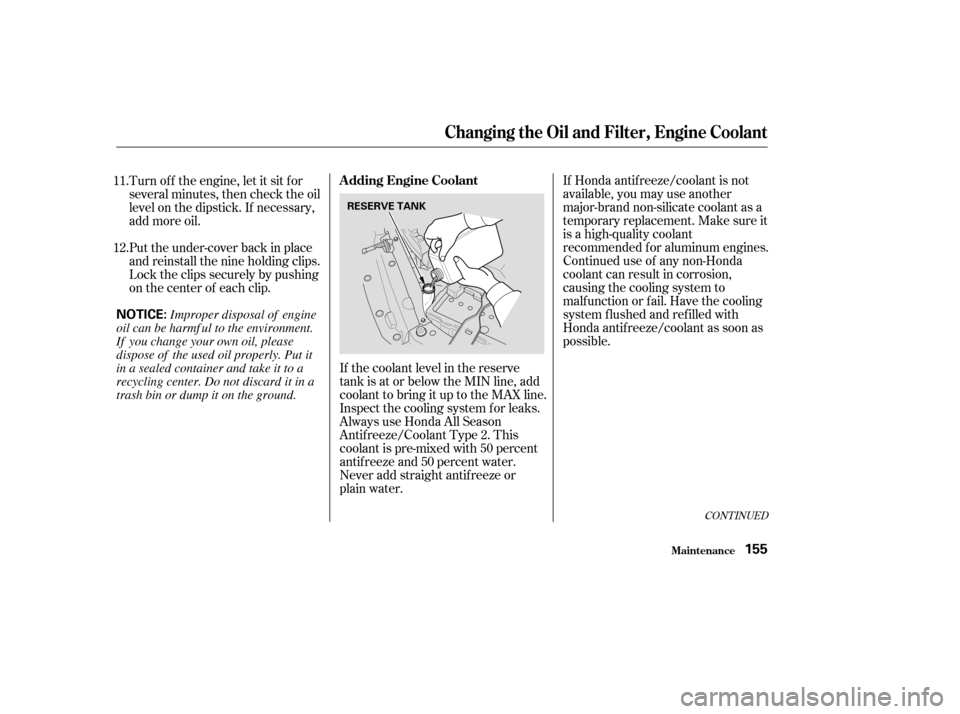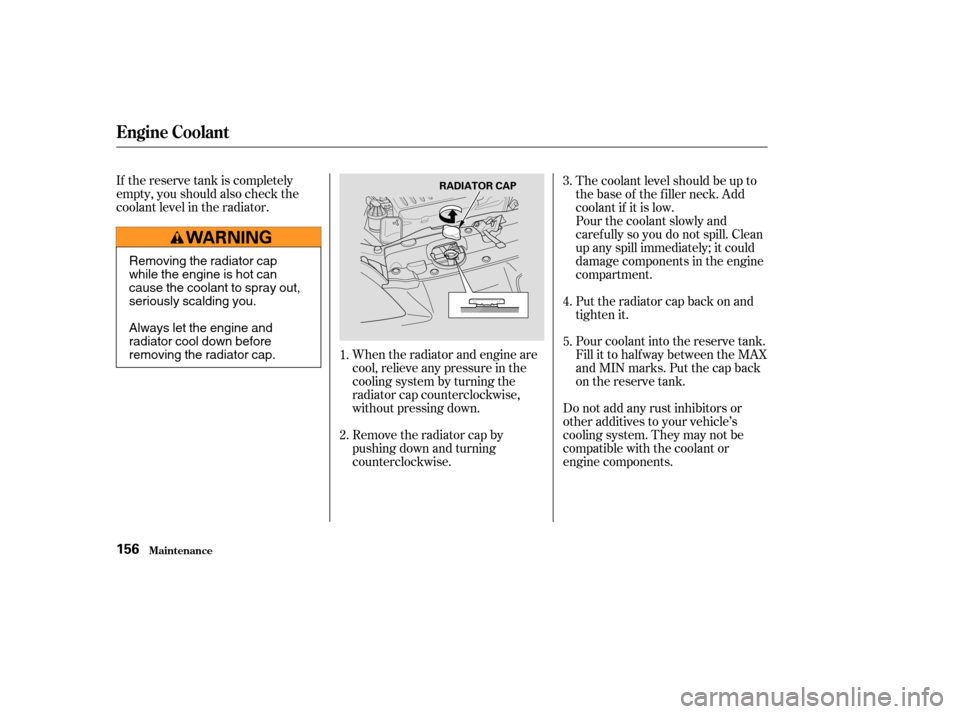Page 5 of 231
Your Vehicle at a Glance
2
AIRBAGSHEATING/COOLING CONTROLS
FUEL FILL DOOR RELEASE
HOOD RELEASE
HANDLE
POWER WINDOW
SWITCHES
MANUAL TRANSMISSION
TRUNK RELEASE POWER DOOR
LOCK SWITCH INSTRUMENT PANEL
AUTOMATIC TRANSMISSION (CVT)
(P.
73) (P.
51)
(P. 115)
(P. 74)
(P.117) (P.
133)
(P. 130) (P.
88)
(P.
10, 22)
(P. 79)
Page 49 of 231

Your vehicle’s exhaust contains
carbon monoxide gas. You should
have no problem with carbon
monoxide entering the vehicle in
normal driving if you maintain your
vehicle properly.High levels of carbon monoxide can
collect rapidly in enclosed areas,
such as a garage. Do not run the
engine with the garage door closed.
Even with the door open, run the
engine only long enough to move the
vehicle out of the garage.With the trunk lid open, air f low can
pull exhaust gas into your vehicle’s
interior and create a hazardous
condition. If you must drive with the
trunk lid open, open all the windows
and set the heating and cooling
system as shown below.
If you must sit in your parked vehicle,
even in an unconf ined area, with the
engine running, adjust the heating
and cooling system as f ollows:
Select the Fresh Air mode.
Select the mode.
Turn the f an on high speed.
Set the temperature control to a
comfortable setting.
Have the exhaust system inspected
f or leaks whenever:
The vehicle is raised f or an oil
change.
You notice a change in the sound
of the exhaust.
The vehicle was in an accident
that may have damaged the under-
side. 1.
2.
3.
4.
Carbon Monoxide Hazard
Driver and Passenger Saf ety46
Carbon monoxide gas is toxic.
Breathing it can cause
unconsciousness and even kill
you.
Avoid any enclosed areas or
activities that expose you to
carbon monoxide.
Page 53 of 231
AT model is shown.
Control L ocations
Inst rument s and Cont rols50
HEATING/COOLING CONTROLS
FUEL FILL DOOR RELEASE
TRUNK RELEASE CRUISE CONTROL SWITCHES
CRUISE CONTROL
MASTER SWITCH
POWER DOOR LOCK
SWITCH
MIRROR
CONTROLS
HOOD RELEASE
HANDLE
POWER WINDOW
SWITCHES AUDIO SYSTEM
DIGIT
AL CLOCK
(P.
88)
ACCESSORY POWER
SOCKET
(P. 109)
(P. 117)
(P. 74)
(P.
115)
(P.
109)
(P.
73)
(P.94)
(P. 108 )
(P.
81)
(P. 79)
(P.85)
Page 66 of 231

If the IMA battery is too hot or too
cold, the IMA system shuts down to
protect the battery. This disables the
IMA assist and Auto Idle Stop, even
though the Battery Level Gauge may
show that the battery is well-charged.
Theref ore, those f unctions may not
operate when you f irst start driving
in very hot or cold weather.This shows the temperature of the
engine’s coolant. During normal
operation, the reading should be in
the middle of the gauge. In severe
driving conditions, the reading may
reach near the red mark. If it
reaches the red (Hot) mark, pull
safely to the side of the road. Turn to
page f or instructions and
precautions on checking the engine’s
cooling system.
The battery temperature will
normalize af ter a f ew minutes of
driving, and the IMA system will
work normally.
This gauge shows you the status of
the Integrated Motor Assist (IMA).
When the IMA battery is being
charged, the lef t side of the gauge
illuminates. When the IMA is
assisting the engine, the right side of
the gauge illuminates. 187
Charge/Assist Gauge
Temperature Gauge
Gauges
Inst rument s and Cont rols63
IMA CHARGE
GAUGEIMA ASSIST
GAUGE
Page 93 of 231

The outside air intakes f or the
heating and cooling system are at
the base of the windshield. Keep this
area clear of leaves and other debris.
ThesystemshouldbeleftinFresh
Air mode under almost all conditions.
Keeping the system in Recirculation
mode, particularly with the A/C of f ,
can cause the windows to fog up.
Switch to Recirculation mode when
driving through dusty or smoky
conditions, then return to Fresh Air
mode.
This button turns the rear window
def ogger of f and on (see page ).
Use the mode control dial to select
the vents the air flow from. Some air
will f low f rom the dashboard vents in
all modes.Air flows from the center
and corner vents in the dashboard.
Air f low is divided between
the vents in the dashboard and the
f loor vents.
Air f lows f rom the f loor
vents. When you select , the
system automatically switches to
Fresh Air mode.
Air f low is divided between
the f loor vents and the def roster
vents at the base of the windshield.
Air f lows f rom the def roster
vents at the base of the windshield.
Turn this dial to control fan speed
and the air flow.
When the dial is set to AUTO, the
system controls the f an speed
automatically.
Turning this dial clockwise increases
the temperature of the airflow.
This button turns the air
conditioning on and of f . The light in
thebuttonisonwhentheA/Cison.
When the light in the button is on,
air f rom the vehicle’s interior is sent
throughout the system again. When
the light is of f , air is brought in f rom
the outside of the vehicle (Fresh Air
mode).
When you select or ,
the system automatically switches to
Fresh Air mode and turns on the
A/C and turns off the ECON mode.
68
Fan Control Dial
Rear Window Def ogger Button
Mode Control Dial
Air Conditioning (A/C) Button T emperature Control Dial
Recirculation Button
Comf ort and Convenience Feat ures
Vents, Heating, and A/C
90
Page 95 of 231

To use the heating and cooling
system in automatic mode, set the
system as f ollows.Set the f an control dial to AUTO.
Set the mode control dial to AUTO.
Set the desired temperature by
turning the temperature control
dial. Turning this dial clockwise
increases the temperature of the
air flow.
Select Fresh Air mode. The
indicator in the button should be
off.
Turn on the A/C by pressing the
button f or cooling and dehumidi-
f ying. The indicator in the button
lights. To heat or cool the interior f aster,
select Recirculation mode and set
the temperature control dial to the
upper or lower limit.
When you set the temperature to its
lower or its upper limit, the system
runs at f ull cooling or heating only. It
does not regulate the interior
temperature.
TurningthefancontroldialtoOFF.
However, a lack of air flow can cause
the windows to fog up. It is
recommended that you keep the f an
on at all times so stale air and
moisture do not build up in the
interior and cause f ogging.
1.
2.
3.
4.
5.
Comf ort and Convenience Feat ures
Automatic Operation
To Turn Everything Of f
Vents, Heating, and A/C
92
Page 158 of 231

If Honda antif reeze/coolant is not
available, you may use another
major-brand non-silicate coolant as a
temporaryreplacement.Makesureit
is a high-quality coolant
recommended f or aluminum engines.
Continued use of any non-Honda
coolant can result in corrosion,
causing the cooling system to
malf unction or f ail. Have the cooling
system f lushed and ref illed with
Honda antif reeze/coolant as soon as
possible.
If the coolant level in the reserve
tank is at or below the MIN line, add
coolant to bring it up to the MAX line.
Inspect the cooling system f or leaks.
Always use Honda All Season
Antif reeze/Coolant Type 2. This
coolant is pre-mixed with 50 percent
antif reeze and 50 percent water.
Never add straight antifreeze or
plain water.
Turn of f the engine, let it sit f or
several minutes, then check the oil
level on the dipstick. If necessary,
add more oil.
Put the under-cover back in place
and reinstall the nine holding clips.
Locktheclipssecurelybypushing
on the center of each clip.
11.
12.
CONT INUED
Maint enance
A dding Engine Coolant
Changing the Oil and Filter, Engine Coolant
155
NOTICE:
RESERVE TANK
Improper disposal of engine
oil can be harmf ul to the environment.
If you change your own oil, please
dispose of the used oil properly. Put it
in a sealed container and take it to a
recycling center. Do not discard it in a
trash bin or dump it on the ground.
Page 159 of 231

If the reserve tank is completely
empty, you should also check the
coolant level in the radiator.When the radiator and engine are
cool, relieve any pressure in the
cooling system by turning the
radiator cap counterclockwise,
without pressing down.
Remove the radiator cap by
pushing down and turning
counterclockwise.The coolant level should be up to
the base of the f iller neck. Add
coolant if it is low.
Pour the coolant slowly and
caref ully so you do not spill. Clean
up any spill immediately; it could
damage components in the engine
compartment.
Put the radiator cap back on and
tighten it.
Pour coolant into the reserve tank.
Fill it to half way between the MAX
and MIN marks. Put the cap back
on the reserve tank.
Do not add any rust inhibitors or
other additives to your vehicle’s
cooling system. They may not be
compatible with the coolant or
engine components.
1.
2. 3.
4.
5.
Engine Coolant
Maint enance156
RADIATOR CAP
Removing the radiator cap
while the engine is hot can
cause the coolant to spray out,
seriously scalding you.
Always let the engine and
radiator cool down before
removing the radiator cap.